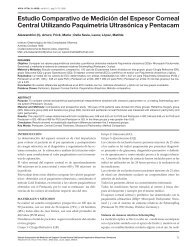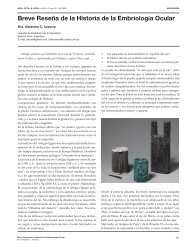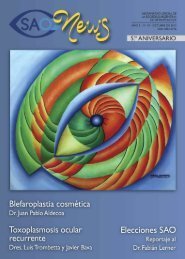Volumen 79 Número 1 - Sociedad Argentina de Oftalmología
Volumen 79 Número 1 - Sociedad Argentina de Oftalmología
Volumen 79 Número 1 - Sociedad Argentina de Oftalmología
You also want an ePaper? Increase the reach of your titles
YUMPU automatically turns print PDFs into web optimized ePapers that Google loves.
General Conditions for publishing in Archivos <strong>de</strong> <strong>Oftalmología</strong> <strong>de</strong> Buenos Aires<br />
be quantified whenever possible, presenting<br />
them with a<strong>de</strong>quate indicators regarding error<br />
or uncertainty measures (such as confi<strong>de</strong>nce<br />
intervals). The suitability of the experimentation<br />
subjects must be discussed, providing <strong>de</strong>tails<br />
on randomisation. Describe also the methods of<br />
any type of blind observation technique and any<br />
treatment complications. Specify the number of<br />
observations and mention any cases lost therein<br />
(such as dropouts in clinical essays). Specify<br />
the utilisation of any computer programme of<br />
general use.<br />
· Results<br />
Describe only the results extracted from<br />
the previous section. Refrain from repeating<br />
all data tables and/or illustrations. Restrict the<br />
amount of tables and figures to illustrate and<br />
support the reasoning of the article. Use graphs<br />
as an alternative to tables with many data, and<br />
avoid duplicating data in graphs and tables.<br />
· Discussion<br />
This section should refer only to data<br />
obtained in the results, the possible limitations<br />
thereof and a comparison with those of other<br />
authors. Emphasise the novel and relevant<br />
aspects of the work and the conclusions <strong>de</strong>rived<br />
from it. Avoid speculations which, if ma<strong>de</strong>, must<br />
be clearly i<strong>de</strong>ntified as such and not as a proven<br />
fact. Do not claim priority or refer to unfinished<br />
work.<br />
· Acknowledgements<br />
The persons who ma<strong>de</strong> an intellectual<br />
contribution to the article but do not merit<br />
authorship can be named here, provi<strong>de</strong>d<br />
they have given their authorisation. The<br />
authors are responsible for obtaining written<br />
authorisation from the persons mentioned in the<br />
acknowledgements because rea<strong>de</strong>rs can infer<br />
their support to the data and conclusions.<br />
Technical support is to be acknowledged<br />
in a separate section, together with other<br />
contributions.<br />
o Bibliography<br />
It must be or<strong>de</strong>red and numbered<br />
with Arabic numbers by or<strong>de</strong>r of appearance<br />
in the text. Any entry in this section must<br />
[ 74 ]<br />
have its counterpart in the text, just like any<br />
quote in the text must have its matching<br />
bibliographical entry if published in a standard<br />
publication. References to personal or poster<br />
communications, summaries of programmes<br />
and unpublished discussions must be kept to a<br />
minimum and i<strong>de</strong>ntified in the text, although not<br />
in the bibliography. In these cases, the author<br />
must supply the documentation object of the<br />
reference or the author’s acceptance in writing.<br />
The format of the quote shall follow<br />
that of the In<strong>de</strong>x Medicus.<br />
· For the Archives<br />
Regarding journals, the quote must<br />
inclu<strong>de</strong>: a) Author/s, with surname/s and<br />
name initial/s, without separation by periods<br />
or commas. When quoting several authors, a<br />
comma shall be used to separate each name,<br />
avoiding the use of «and». If the number of<br />
authors exceeds six, the first six shall be named<br />
followed by «et al». The last shall be followed<br />
by a period; b) Article title in original language,<br />
with its own signs and accentuations, followed<br />
by a period; c) In<strong>de</strong>xed journal name. After each<br />
abbreviation of the journal name no period<br />
shall be inclu<strong>de</strong>d, not even between the last<br />
abbreviation and section d). To facilitate the<br />
<strong>de</strong>nomination of the abbreviated title of each<br />
journal quotes, see list of abbreviated titles<br />
at the end of these rules; d) Year; e) Volume<br />
number. The separation between this section<br />
and section f ) shall be ma<strong>de</strong> with a colon; f ) First<br />
and last pages, separated by a dash (-).<br />
For instance: Josselson J. Kyser BA, Weir<br />
MR, Sadler JH. Hepatitis B surface antigenemia in<br />
chronic haemodialysis program: lack of influence<br />
on morbidity and mortality. Am J Kidney Dis<br />
1987; 9: 4 6461.<br />
· For books<br />
a) Author, followed by a period; b) Title,<br />
followed by a period; c) Edition, if more than one;<br />
d) Publisher city and house; e) Year; f) Volume,<br />
if more than one, and pages, if referring to a<br />
specific quote and not the entire book.<br />
Example: Boyd B. Atlas <strong>de</strong> Cirugía Ocular.<br />
Panama: Highlights of Ophthalmology; 199 ; II; 4<br />
· For book chapters<br />
a) Chapter author; b) Chapter title; c) In: book<br />
author; d) Book title; e)Publisher city and house;<br />
f) Year; g) Volume, if more than one, and pages.






